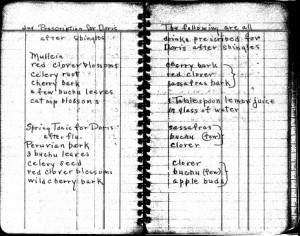Whenever I, in another frenzy of research, dive into the bins of my family documents, artifacts, heirlooms, and memorabilia, I usually know what I’m looking for with little idea of what I’ll actually find, like my paternal grandmother’s herbal “recipes.” While there are more musicians in my family than medicine men or women, no one ever sang “A spoonful of sugar” to me as a child when I had to swallow my grandmother’s concoctions, decoctions, teas, infusions, tonics, and “prescriptions.” That I now remember crawley root tea in particular is evidence that it has indeed scarred me for life.
Grandmother Winifred Sturgis Lee Church (1884–1979) would be known today as an herbalist. In 1692 Salem, she’d have been accused as a witch for her knowledge of natural cures and medicines. Winnie spent her earliest years on the Kansas plains while her father farmed and grew wheat on his 300 acres. I suspect her knowledge of herbs, plants, roots, barks, and flowers came from her mother and contact with local Native Americans, including those in and around her home in Maine.
It was while I was researching other matters for an aspiring murder mystery author that I came across Winnie’s handwritten “Herbal Prescriptions” notebook, a thin wire-bound book with yellowing pages. The “recipes” are still clearly written, noting tonic ingredients “for nervous, run down condition” or spring tonics for her husband and children: “Tonic for Doris after shingles” and “2nd prescription for Doris after shingles.”
Poor severely-shingled Doris. Apparently the concoction of beech leaves (“the dry leaves left on the tree in winter – not green leaves”), tips of cherry and some bark, sassafras bark, smartweed, and dandelion root brewed and served in a wineglass four times a day didn’t work, so then came an infusion of mullein, red clover blossoms, celery root, cherry bark, a few buchu leaves, and catnip blossoms. Bottoms up!

 But wait! Poor Doris had more to endure because there follows in the notebook four more recipes for drinks for her “after shingles.”
But wait! Poor Doris had more to endure because there follows in the notebook four more recipes for drinks for her “after shingles.”
The previously mentioned crawley root is botanically known as Corallorhiza odontorhiza, or scaly dragon’s claw, coral root, and chicken toe, all names to indicate the root’s appearance if not its gastronomic appeal. Winnie knew it would produce sweat and break a fever, as well as act as a sedative. I can tell you from personal experience that the stuff works . . . if you can swallow the astringent liquid, reminiscent of commercial fertilizer. Winnie never added that crucial spoonful of sugar or honey!
I should note here that all of my grandmother’s family survived these ministrations quite well, and lived or are living long lives. Whether that is because of these prescriptions or in spite of them, I can’t say, and I’m not so sure about the rest of her patients. My grandparents owned a horse with a sore, cloudy eye. A local psychic’s Native American “spirit guide” suggested a cure for the eye and the underlying abscess. My grandmother wrote down the following recipe: “to cure cataracts: mix powdered sugar with skim milk. Drop in eyes with medicine dropper. Heat sugar in oven to kill any germs. This worked on a horse.”
Hooray for the horse!
I’ve researched all of these ingredients, and I knew my grandmother well enough to know that easing symptoms, not hastening misery, was certainly her intent. All of her herbs, flowers, and barks really do have medicinal properties and healthy, safe uses, with the possible exception of the cataract cure. You’re welcome to my portion!
Share this:

About Jan Doerr
Jan Doerr received a B.A. degree in Sociology/Secondary Education from the University of New Hampshire, and spent a long career in the legal profession while researching her family history. She has recently written and published articles for WBUR.org’s Cognoscenti blog: “Labor of Love: Preserving a 226-Year-Old Family Home and Preparing to Let It Go” and “The Value of Family Heirlooms in a Digital Age.” Jan currently lives with her attorney husband in Augusta, Maine, where she serves two Siamese cats and spends all her retirement money propping up a really old house.View all posts by Jan Doerr →
